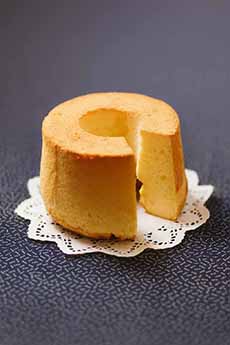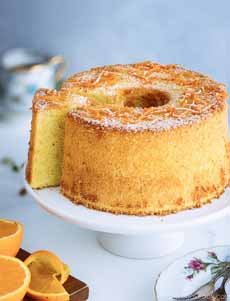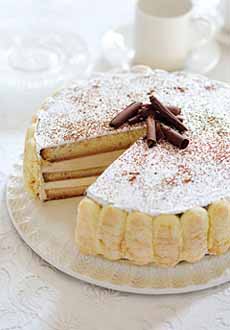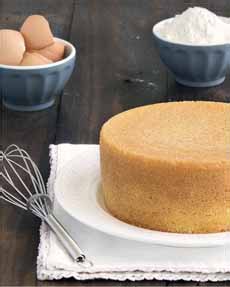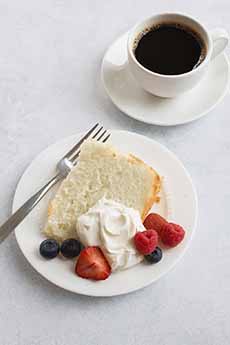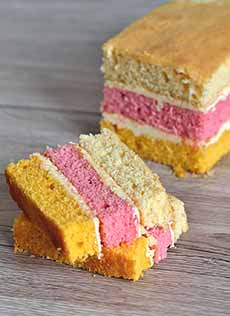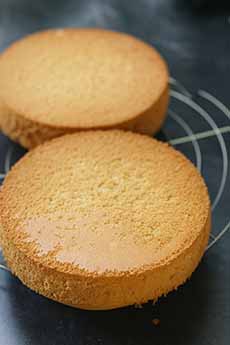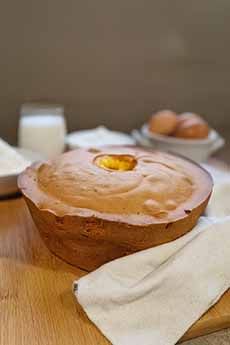> The year’s 55 cake holidays.
> The history of sponge cake.
> The history of cake.
> The different types of cake: a photo glossary.
THE DIFFERENT TYPES OF SPONGE CAKE
Most sponge cakes are made with eggs, sugar, flour, and sometimes a small amount of fat (melted butter or vegetable oil). They are usually leavened with beaten eggs so no baking powder or other leavening is needed (the difference between baking powder and baking soda).
While this article doesn’t propose to be a comprehensive treatise on sponge cakes, there are three ways of grouping them.
Foam Sponge / True Sponge
These include Australian (cornflour) sponge, castella, génoise, pan di Spagna, and Viennese sponge.
What designates them as foam/true sponge?
The rise: They rise from an egg foam, air whipped into whole eggs or separated yolks/whites. There is no chemical leavening (baking powder, baking soda).
Fat: None or minimal.
Mixing method: Eggs and sugar are whisked into a stable foam; then the flour is folded in, often with some cornstarch.
Texture: These cakes have a springy, drier crumb that’s flexible for roulades and ideal for syrup-soaking.
Greasing: The pans are often ungreased so the batter can climb the sides (the bottoms only can be lined). Angel food cake and Passover sponges need to be inverted when the pan comes out of the oven so they keep their volume (don’t shrink) while their starch/protein network sets firm.
Butter Sponge / Cream Sponge
These include he American/hot-milk sponge, any recipe called butter/cream sponge, the Victoria sponge (photo #__), plus variants (e.g. Madeira sponge cake, many “butter sponge” recipes..
What designates them as butter/cream sponge?
Because they contain butter (some people use oil), they also fall into the category of butter cakes.
The rise: They rise from from creamed butter and sugar (mechanically aerated fat) plus baking powder/soda.
Fat: Butter is a main ingredient.
Mixing method: The eggs are added to the creamed butter and sugar, followed by the flour, and sometimes milk.
Texture: These cakes are moister and richer, with a finer crumb. They are meant to be filled/frosted without syrup (although syrup is optional).
Greasing: The pans are greased. No inversion is required.
Hybrids
Chiffon cake uses the egg foam from the foam/true sponge, and fat (typically oil) and baking powder from the butter/cream sponge.
Japanese shortcake sponge similarly uses egg foam, the foam/true sponge-cake aeration technique. Like a butter/cream sponge, it’s enriched with warm milk and melted butter (or oil)—these dairy ingredients creating a softer, moister, finer crumb. Often, a pinch of baking powder for “insurance†.”
The Types Of Sponge Cake
American sponge is a hot-milk sponge: Whole eggs are whipped until foamy, then hot milk and melted butter are added, and often a bit of baking powder. It is baked as layers to be filled, more like a classic layer cake than a syrup-soaked (i.e. brushed or poured on) European sponge. It has a moist, fine crumb. Fillings include jam, lemon curd, macerated berries, pastry cream, with frostings such as buttercream, chocolate ganache, 7-minute, and whipped cream.
Angel food cake (photo #9). Is angel food cake a sponge? Culinarians don’t agree as to yes or no. See the discussion below.
Australian sponge is a firm whisked sponge (an “Australian sponge”—eggs and sugar whipped, flour folded in, sometimes a little melted butter/cornstarch)
Biscuit de Savoie, A classic French sponge that’s lighter than génoise, traditionally made without butter.
Biskuit, a German/Austrian sponge cake base used to make cakes in three-or-four layers and also used as a base for a torte (photo #2).
Castella (Kasutera) is traditional Nagasaki loaf cake descended from Portuguese pão-de-ló whole-egg foam, no added fat, sweetened with honey (often mizuame); it commonly uses bread flour (photo #3). The result is a tight, springy, elastic crumb with a glossy, browned top; subtly honey-sweet. It’s baked as a loaf or block mold and served plain in slices. Castella is not the same as Japanese sponge; it is a much older confection that traces to the mid-16th-century in the Nanban period when Portuguese traders and Jesuit missionaries reached Japan. They brought Iberian sponge cakes (like pão-de-ló/“bolo de Castela,” i.e., “Castile cake”), which confectioners in Nagasaki, a main port city adapted. In the early 1600s (early Edo period) local bakers refined the recipe into a fat-free, honey-sweetened loaf baked in wooden molds. The cake became a signature Nagasaki sweet that was later standardized and popularized nationwide by specialty bakers. The name kasutera is the Japanese name for a locally developed style.
Chiffon cake (photo #4), an American invention, is a hybrid of sponge and génoise. It uses a leavening agent and oil, which makes the cake moist than a sponge. The yolks and oil are beaten with the dry ingredients; the whites are whipped separately and folded in. Here’s the history of chiffon cake.
Fatless Sponge is a British-style sponge made without fat, relying entirely on beaten eggs for leavening. The whole eggs are typically whipped together (or sometimes separated and recombined). Has a more substantial, albeit still light, texture than with a golden color from the egg yolks.
Genoese or Genovese or Italian sponge cake is the original sponge cake, made without leavening but with conventional flour and fat. It was invented in the Italian city of Genoa (one story says it was made in Spain, by the Genoese ambassador to Spain [i.e., his cook]). It is often confused with pan di spagna, but the two are different (pan di spagna, below).
Génoise, the famous French sponge (photo #5), has added fat. Clarified butter enriches the batter and makes the cake moister. The eggs are beaten whole, sometimes with additional yolks. Génoise is used in layer cakes and roulades (rolled cakes), among others. Pan di Spagna (see below) is a variation.
Japanese Shortcake Sponge is ultra-soft, very fine, moist, and designed to stay tender when chilled, e.g. with whipped cream for strawberry shortcake (photo #6). It is made with whole-egg foam and warm milk and butter (or neutral oil); some bakers use a bit of baking powder with the flour. The recipe is optimized for pairing with fresh whipped cream rather than buttercream, jam, or other filling. This soft shortcake sponge is different from castella, which is honey-forward, fat-free sponge cake.
Jewish-style sponge cake or Passover sponge cake (photo #1) was adapted by Italian Jews for Passover (so were Italian amaretti—here’s an amaretti recipe), because it contains no leavening. It then spread through other European Jewish communities. The recipe for Passover contains no wheat flour, which is forbidden during the holiday. Instead, matzo cake meal is used, although year-round can use cake flour. It has no added fat, and the yolks and whites are beaten separately. It is typically baked in a tube pan.
Ladyfingers or sponge fingers or savoiardi, a form of Italian sponge, are finger-shaped sponge cookies that originated in late 15th century Italy at the court of the Duchy of Savoy. They are eaten as plain or with a dessert with coffee and a dip (chocolate sauce, lemon curd, zabaglione; in layered and soaked desserts (icebox cakes, tiramisu, trifles/zuppa inglese; as a liner for charlottes, entremets collar (biscuit collar) as in photo #7; ice-cream cakes, ice cream sandwiches, or semifreddos; even as no-bake crusts and crunchy garnishes. Here’s more about them.
Pan di Spagna (“Spanish bread”—photo #8) is another type of Italian sponge cake. While genoese is made by cooking the eggs and sugar together, whisking them over a bain marie and then adding some melted butter, pan di spagna is made without heat. With pan di spagna, the eggs are whisked separately. The lightness is achieved by whipping the whites into stiff peaks, and there is no added fat. This technique is the same as with Jewish-style sponge cake, except that pan di spagna uses traditional flour. Zuppa inglese is an example of a dessert with pan di spagna.
Pão de Ló (photo #14) is a very light and airy Portuguese sponge cake that was the inspiration for castella.
Viennese Sponge (biscuit viennois, photo #13) has a flexible, slightly drier crumb than American sponge and takes syrup beautifully (e.g. for roulades). It uses little or no butter and no chemical leavener. Eggs whites and yolks whipped separately, then folded. There is often some cornstarch added to the flour.
Other sponge cakes, which are variations of the above, include Lamington sponge (from Australia, a jam-filled sponge sandwich dipped in chocolate and covered in coconut, photo #12), Victoria sponge/Victoria sandwich (U.K.—photo #12).
RECIPE: PASSOVER/JEWISH SPONGE CAKE
This recipe is from our mom. Although she is no longer here to bake it, she would be pleased if you did.
Ingredients
12 medium or small eggs, carefully separated
1 cup sugar
Juice and zest from 1 lemon
1/2 cup orange juice
1/2 cup potato starch
1/2 cup matzo meal
Pinch salt
Preparation
1. PREHEAT the oven to 325°F. Separate the egg yolks from the whites, being sure not to get a single drop of yolk mixed into the whites (otherwise the cake will not rise properly).
2. BEAT the yolks; then add the sugar, lemon and orange juices.
3. SIFT the matzoh meal and potato starch together, then add to the yolks. Using a clean bowl and beaters with no trace of the other ingredients…
4. BEAT the egg whites with a dash of salt in a large bowl, until they are fluffy and stiff (the peaks should separate from the sides of the bowl). Fold in the yolk mixture a bit at a time. Pour into an un-greased tube pan (photo #3) and bake for 50 minutes.
5. TURN the pan upside down to cool. Be sure the top of the cake does not touch the surface, or it will mash in.
WHAT TO ADD TO SPONGE CAKE
Mom served this cake as a strawberry shortcake, with whipped cream, berries and the sponge instead of biscuits.
This cake is so versatile that you can serve plain, fancy or in-between.
Mix and match as you like:
Berries or other fruit (sliced stone fruit in the summer)
Citrus glaze and julienned peel (lemon, lime, orange—add some liqueur if you like)
Fruit curd
Fruit sauce
Ice cream (try vanilla, strawberry or other fruit flavor)
Ice cream sundae (sponge cake, ice cream, chocolate or butterscotch sauce)
Whipped cream
Garnishes: chocolate curls, nuts
ARE ANGEL & CHIFFON CAKES SPONGE CAKES?
This is an ongoing debate among bakers, culinary schools, and food writers about whether angel food is part of the sponge cake category.
Similar to sponge cake: it relies on beaten eggs (although whites only) for leavening rather than chemical leaveners. It uses the foam method of mixing, and is fat-free like many classic sponges. It delivers the light, airy texture characteristic of sponge cakes.
Not similar: Many culinary professionals classify angel cake separately from sponge. They call it a “foam cake” or N “egg white cake,” as it uses only egg whites while traditional sponges use whole eggs. Then, it has a distinctly different texture, more ethereal and delicate than typical sponge cakes, with an ultra-light, snowy crumb.
Angel Cake Vs. Angel Food Cake
In American baking, the whites-only foam cake baked in a tube pan is properly called angel food cake. When the term “angel cake” is used for this cake, it can be problematic. That’s because…
In the U.K., “angel cake” a different type of cake: a pink/yellow/white striped butter sponge.
For clarity in your article, stick with angel food cake unless you’re specifically describing the British
Chiffon Cakes
In bakery textbooks, cakes are often grouped as foam cakes, i.e., leavened with egg-foam–leavened. These books list angel food cake, chiffon cake, and sponge cake in this category.
Strictly speaking, chiffon isn’t a classic sponge because it adds oil and baking powder. Classic sponges (génoise/Viennese/Passover) rely on egg foam only, and little or no added fat.
________________
*Ermine frosting, also known as flour frosting or boiled milk frosting, is an old-fashioned recipe: a light, fluffy buttercream that uses a cooked flour-milk mixture to create a less sweet, more stable, and velvety smooth icing. It is an eggless alternative to other types of buttercream, delivering milder sweetness and a creamy, whipped-cream-like texture without the richness of other frostings.
†A small amount of double-acting baking powder releases CO₂, which backs up the egg foam. The gas inflates the bubbles the egg foam has already created, providing the volume needed even if the foam was slightly under-whipped or lost some air while folding in the warm milk/butter.
Plus, while the hot milk and butter soften the texture, they also weigh down the foam. The baking powder supplies extra lift and spring. Finally, the second CO₂ release from the double-[acting baking powder helps hold height of the cake until the structure firms—i.e., fewer collapsed layers.
